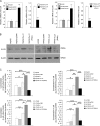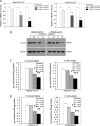A mutant of hepatitis B virus X protein (HBxDelta127) promotes cell growth through a positive feedback loop involving 5-lipoxygenase and fatty acid synthase
- PMID: 20126469
- PMCID: PMC2814349
- DOI: 10.1593/neo.91298
A mutant of hepatitis B virus X protein (HBxDelta127) promotes cell growth through a positive feedback loop involving 5-lipoxygenase and fatty acid synthase
Abstract
Hepatocellular carcinoma (HCC) is one of the most common malignant tumors worldwide. Hepatitis B virus X protein (HBx) contributes to the development of HCC, whereas HBx with COOH-terminal deletion is a frequent event in the HCC tissues. Previously, we identified a natural mutant of HBx-truncated 27 amino acids at the COOH-terminal (termed HBxDelta127), which strongly enhanced cell growth. In the present study, we focused on investigating the mechanism. Accordingly, fatty acid synthase (FAS) plays a crucial role in cancer cell survival and proliferation; thus, we examined the signaling pathways involving FAS. Our data showed that HBxDelta127 strongly increased the transcriptional activities of FAS in human hepatoma HepG2 and H7402 cells. Moreover, we found that 5-lipoxygenase (5-LOX) was responsible for the up-regulation of FAS by using MK886 (an inhibitor of 5-LOX) and 5-LOX small interfering RNA. We observed that HBxDelta127 could upregulate 5-LOX through phosphorylated extracellular signal-regulated protein kinases 1/2 and thus resulted in the increase of released leukotriene B4 (LTB4, a metabolite of 5-LOX) by ELISA. The additional LTB4 could upregulate the expression of FAS in the cells as well. Interestingly, we found that FAS was able to upregulate the expression of 5-LOX in a feedback manner by using cerulenin (an inhibitor of FAS). Collectively, HBxDelta127 promotes cell growth through a positive feedback loop involving 5-LOX and FAS, in which released LTB4 is involved in the up-regulation of FAS. Thus, our finding provides a new insight into the mechanism involving the promotion of cell growth mediated by HBxDelta127.
Figures







Similar articles
-
A mutant of HBx (HBxDelta127) promotes hepatoma cell growth via sterol regulatory element binding protein 1c involving 5-lipoxygenase.Acta Pharmacol Sin. 2010 Mar;31(3):367-74. doi: 10.1038/aps.2010.5. Epub 2010 Feb 22. Acta Pharmacol Sin. 2010. PMID: 20173757 Free PMC article.
-
Hepatitis B virus X protein mutant HBxΔ127 promotes proliferation of hepatoma cells through up-regulating miR-215 targeting PTPRT.Biochem Biophys Res Commun. 2014 Feb 7;444(2):128-34. doi: 10.1016/j.bbrc.2014.01.004. Epub 2014 Jan 14. Biochem Biophys Res Commun. 2014. PMID: 24434140
-
Hepatitis B virus X protein drives multiple cross-talk cascade loops involving NF-κB, 5-LOX, OPN and Capn4 to promote cell migration.PLoS One. 2012;7(2):e31458. doi: 10.1371/journal.pone.0031458. Epub 2012 Feb 15. PLoS One. 2012. PMID: 22355367 Free PMC article.
-
A novel positive feedback loop involving FASN/p-ERK1/2/5-LOX/LTB4/FASN sustains high growth of breast cancer cells.Acta Pharmacol Sin. 2011 Jul;32(7):921-9. doi: 10.1038/aps.2011.40. Epub 2011 Jun 6. Acta Pharmacol Sin. 2011. PMID: 21643005 Free PMC article.
-
Hepatitis B virus X protein sensitizes UV-induced apoptosis by transcriptional transactivation of Fas ligand gene expression.IUBMB Life. 2005 Sep;57(9):651-8. doi: 10.1080/15216540500239697. IUBMB Life. 2005. PMID: 16203685 Review.
Cited by
-
The First Yarrowia lipolytica Yeast Models Expressing Hepatitis B Virus X Protein: Changes in Mitochondrial Morphology and Functions.Microorganisms. 2022 Sep 10;10(9):1817. doi: 10.3390/microorganisms10091817. Microorganisms. 2022. PMID: 36144419 Free PMC article.
-
Molecular mechanism of hepatitis B virus X protein function in hepatocarcinogenesis.World J Gastroenterol. 2015 Oct 14;21(38):10732-8. doi: 10.3748/wjg.v21.i38.10732. World J Gastroenterol. 2015. PMID: 26478665 Free PMC article. Review.
-
Hepatitis B virus X protein promotes hepatoma cell proliferation via upregulation of MEKK2.Acta Pharmacol Sin. 2011 Sep;32(9):1173-80. doi: 10.1038/aps.2011.52. Epub 2011 Aug 1. Acta Pharmacol Sin. 2011. PMID: 21804577 Free PMC article.
-
Hepatitis B virus DNA integration as a novel biomarker of hepatitis B virus-mediated pathogenetic properties and a barrier to the current strategies for hepatitis B virus cure.Front Microbiol. 2022 Sep 2;13:972687. doi: 10.3389/fmicb.2022.972687. eCollection 2022. Front Microbiol. 2022. PMID: 36118192 Free PMC article. Review.
-
Dinosaurs and ancient civilizations: reflections on the treatment of cancer.Neoplasia. 2010 Dec;12(12):957-68. doi: 10.1593/neo.101588. Neoplasia. 2010. PMID: 21170260 Free PMC article.
References
Publication types
MeSH terms
Substances
LinkOut - more resources
Full Text Sources
Medical
Research Materials
Miscellaneous
